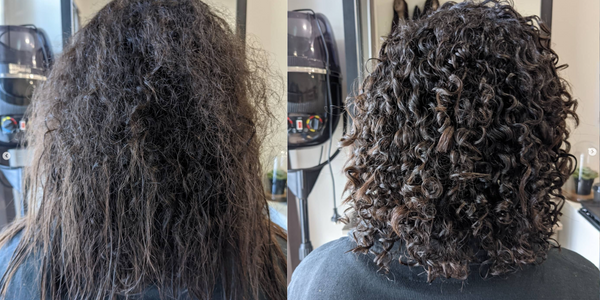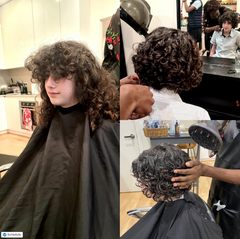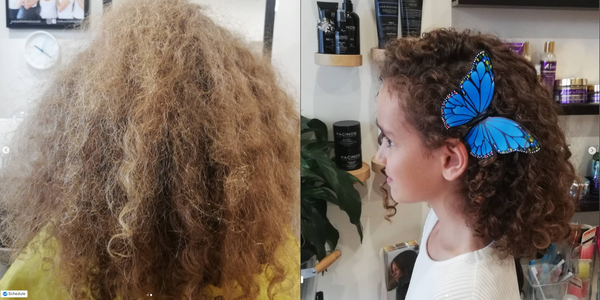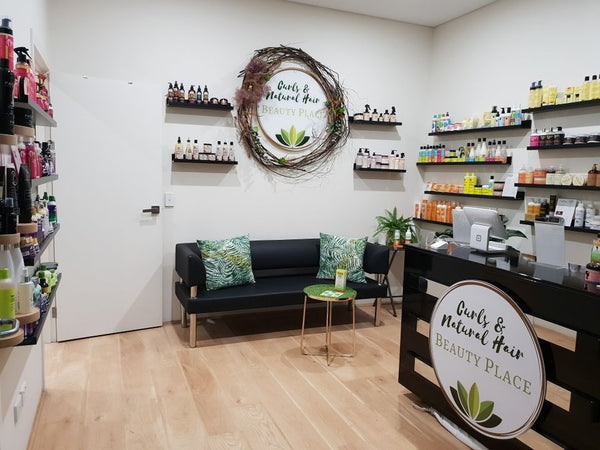THE CURLY GIRL METHOD 101 – Part 4: HEAR FROM A CURLY HAIR EXPERT
The internet is an ocean of curly hair tips, tricks, hacks, insights, advice, opinions, tutorials, and hints. But how do you know if curly hair wisdom is on the straight and narrow?
Sometimes, it’s best to take your curly hair queries straight to the source and hear directly from the experts. That’s why we sat down for a brilliant interview with an amazingly talented hairdresser, Leonie Dawkins, who works at Curls & Natural Hair Beauty, a Sydney salon specialising in curly hair care.
For the fourth and final part in our Curly Girl Method 101 series, we thought it best to hear from a curly hair expert and supplement the fundamentals of the Curly Girl Method!
Check out our interview below to learn more about curly hair products, overnight curl care, and the unsung heroes at your friendly local curly hair salon!
Why are styling products so important for daily curly maintenance?

(image: Amadou (Wuli Founder & Leonie)
Leonie says the right styling products are the difference between healthy, moisturised curls and the Sahara desert. “It keeps your curls in place, you know,” she said, “because curls dry up very easily, so you definitely need a good styling product to keep it hydrated.”
However, Leonie also threw some cold water on using too many styling products on curly hair. “All you need is a good moisturising shampoo,” she said. “If your hair is oily, you need a shampoo that counteracts the oiliness, and once you’re finished, sometimes you’ll have a good treatment in between, but all you need is a really good cream, gel or a good mousse. You don’t need anything else.”
While your curls will benefit from fewer products, you may want to keep your curly hair arsenal loaded for different conditions. Leonie says seasonal and climate changes can frazzle your products’ performance. “If you live in a cold climate, your curls will change, or [with] a little bit of hot weather, you may also change your product’s performance,” she says. “Because your hair sometimes gets too oily in very hot climates, and in cold climates, it gets too hydrated, so you will need more products such as protein to stimulate the hair.”
- Want to learn more about the products that work with the Curly Girl Method? Check out Part 1 of our Curly Girl Method 101 series!
Mastering the diffuser – Your curls will thank you!
A diffuser (or a diffuser attachment for a hair dryer) is a crucial component for any complete curl kit, but knowing how to use it is key. While higher heat and airflow will get the job done faster, Leonie cautions against using too high an energy setting. “Once you put the product in your hair,” she says, “you have to be careful what type of heat you put on it after that… But it is safe to look to use a diffuser because all it does is—it brings your curls together.”
The secret, she says, is in how close you bring the diffuser’s heat to the scalp. “If I want the curls to be tighter, I would actually bring the diffuser closer to the scalp and bunch up the curls on the diffuser’s surface.”

Accept no imitations for quality curl products
Obviously, we know better than most that not all curly hair products are created equal, but Leonie was happy to offer us a bit of vindication! When asked about supermarket hair products and how good they are for your curls, Leonie had plenty to say. “I can’t stress enough that going to the supermarket is not the correct way to find products for your curls,” she said, noting that generic hair products don’t specify which curl type they work best for.
“What type of curls do you have? Do you have hydrated curls? Do your curls need more protein? The supermarket [product] does not fix your hair, because they’re not really worried about what’s good for your hair; they’re just about the bottom line, okay? And I tell my clients that all the time; do not buy stuff in the supermarket—it’s not necessary for your hair.”
Quality doesn’t stop at the product, though. For proper curly care, Leonie says a curly salon will set you straight. “They will definitely explain to [you] about the curls, what type of curls [you] have, and what [you] need for that particular curl [type], and then go out and get the products. I think, for me, that’s the best—that you [have a] really good person that knows about curls, how to cut curls and take care of curls, and away you go.”
• Master your product application and learn how to do the Curly Girl Method with Part 2 of our Curly Girl Method 101 series!
Speaking of curly salons…
As we mentioned, Leonie works at Curls & Natural Hair Beauty Place, a specialist curly salon in Sydney. Curly salons are a great place for expert tips from people who live and breathe curls. You can find curly salons in most cities. They offer a full head of services to cater to curls of all cuts.
What’s more, they know to avoid the common mistakes made by hair stylists with less curly hair experience. Among the biggest mistakes people make caring for the curls?
- Cutting their hair “straight across the board,” rather than cutting curl-by-curl. “Curl-by-curl is the way to go,” Leonie insists.
- Cutting curly hair when wet because “once you wet it, the curls drop down and it’s longer, and when you cut, you [could] misjudge, and you take it up too much.”
Where do these age-old curly miscues come from? Well, Leonie knows a thing or two about that as well. “A lot of people are old school. They were taught only one way back in the day and nobody knew about curly hair. They thought, ‘hair was hair, you can cut it.’ So, the hairdressing schools taught you to cut the hair—curly hair, wet hair, straight hair—everything was the same. And that is why so many people had a lot of problems with their hair, because it was never cut right… Now, we actually understand more about curly hair, and learn that there is a difference… as to how you wash it, how you cut it, the products you use, are all important to maintain good healthy curls. Every step is very important.”
Setting the land speed record for curl care

How can you keep your curly hair routine from twisting your whole day into knots? According to Leonie, a few simple tricks can help you abbreviate your CGM (aka Curly Girl Method), and it all starts the night before.
“I say everybody with curls must have a bonnet. This is my go-to. You must have a bonnet for your curls. Sleep with your bonnet; never mind the husband thinking it’s not attractive. They didn’t think about this in the morning. You’re going to say, ‘Oh, it’s not attractive’—Don’t worry about him! These are your curls. Put your bonnet on so when you sleep, it protects your curls in the morning.
“When you get up, you’ve got a meeting! You haven’t got time for worrying about curls. You will go in the bathroom, wet your hands, run it through your curls and add a touch of curl cream or sea salt spray to reactivate the product that you put in there yesterday or the day before. You don’t necessarily have to put much more product in your hair. Just ‘scrunch, scrunch, scrunch,’ and out the door you go. That’s all you need.”
- Learn how to scrunch and other helpful Curly Girl Method Frequently Asked Questions with Part 3 of our Curly Girl Method 101 series!
If you’d like volume, simply put your head down with your hands underneath, give your curls a shake, and flick them up, and you’re done! Leonie insists that curl maintenance can be “effortless” and that you don’t need to be “adding products on top of more products.” A sea spray bottle or simply wetted hands can provide just enough moisture to reactive the product you used the night before.
Terrific Terry Towels, Marvellous Microfibre
The fabrics you use to care for your curls will play a big role in just how quick and painless your daily curl care routine really is. For Leonie, it’s all about natural fibres. “You’re gonna use a terry towel or natural fibres such as bamboo and cotton,” she says. “It has to be natural. You can use a t-shirt or hair towel made from natural fibres]. Otherwise you just make [your curls] fuzzy.”

It’s never too late to embrace the power and wonder of your curls!
Ultimately, Leonie shares Wuli Grooming’s passion for the natural beauty of our curls. If you’re only just now ready to embrace your curls, she says you should first find a really good stylist who specialises in curly hair. Now, we’re not here to play favourites, but we can think of a salon in the Sydney suburb of Mascot that does great work!
If that’s a bit too far of a trek for you and your curls, Leonie suggested some qualities to look for in a curly hair salon.
“It has to be someone who specialises in curls so that they know all about your hair, they can advise you on the style, the products, the maintenance, such as your shampoo, conditioner, your curl creams, gels, your mousse…What type of mousse? [Because] some mousse contains alcohol. Not every mousse is good for your hair—you need creams and mousses that are going to create moisture. There's got to be moisture in the hair. Same with the gel; if it contains alcohol, it’s a no-no. It's just going to dry out your curls. You really need stuff that’s gonna bring moisture to your hair... So, I suggest you go and see a stylist, somebody who knows about curls, who can advise you the right and proper way onto your journey to get you from A to B and that is a must. So, for the love of your curls, you've got to do that sometimes.”

Parting wisdom for the next generation of curly hair conquerors
Leonie offered some parting wisdom for parents with curly-haired children.
“We have a lot of mums that come in, and they want an education on their children’s curls,” she says. “The first thing they ask is, ‘How do they manage it at home?’ Because we can do it at the salon for them, but when they get home, they’re going to have to learn to deal with it themselves. So, we actually have little mini-lessons that we teach them at Curls & Natural Hair Beauty to take care of the baby’s hair—the curls—how to wash it out, to maintain it, especially those who go to school.
“You don’t really want an awful lot of products in the children’s hair, so we suggest: good washing, good leave-in conditioner, and put the hair back. We don’t put gel in young babies’ hair. And then that’s all you need. They don’t need an awful lot when they’re that age. We do teach [the mums] how to wash it. Washing and good conditioner are very important in a young child’s hair. And we teach us folk—Afro-Caribbean children or Afro-American as well as Pacific Islanders —about protective styles to moisturise and keep the hair and protect the style.
To learn more or book your own consultation with Leonie, please visit: Curls and Natural Hair.